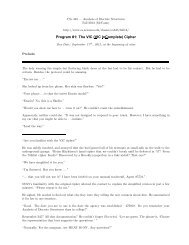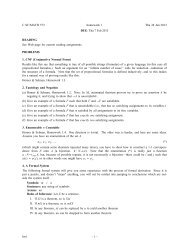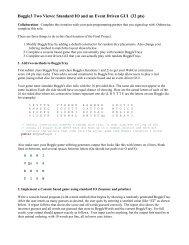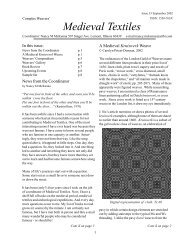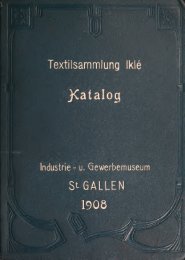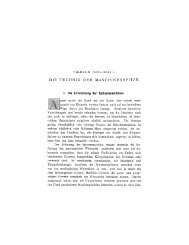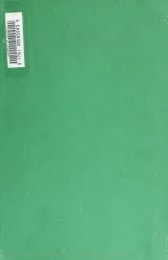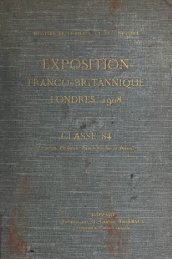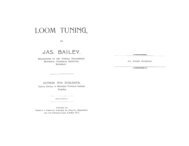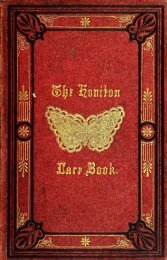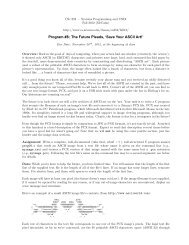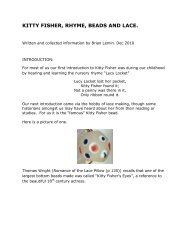The Priscilla Battenberg and point lace book; a collection of lace ...
The Priscilla Battenberg and point lace book; a collection of lace ...
The Priscilla Battenberg and point lace book; a collection of lace ...
Create successful ePaper yourself
Turn your PDF publications into a flip-book with our unique Google optimized e-Paper software.
distance. <strong>The</strong> new thread should then be carried<br />
by the needle in a similar manner along the braid<br />
from the direction opposite that taken by the<br />
retiring thread. At the <strong>point</strong> where the thread is<br />
to be fastened, <strong>and</strong> the work continued, two button-<br />
hole knots are all that is necessary.<br />
It is <strong>of</strong>ten well, when filling in with stitches that<br />
permit, to begin the new thread on the side <strong>of</strong> the<br />
space opposite the ending <strong>of</strong> the former thread.<br />
This serves to make the p<strong>lace</strong> <strong>of</strong> j uncture still less<br />
conspicuous.<br />
All patterns should be able to be considered as<br />
composed <strong>of</strong> two parts — design <strong>and</strong> background.<br />
<strong>The</strong> design should be prominently brought out,<br />
<strong>and</strong>, to accomplish this, the network <strong>and</strong> other<br />
showy stitches should be used, keeping the spider-<br />
webs, bars, <strong>and</strong> other open stitches for the back-<br />
ground. It is well to put in the background,<br />
stitches first, as they will hold the curves <strong>of</strong> the<br />
braid in p<strong>lace</strong>, <strong>and</strong> preserve the shape <strong>of</strong> the de-<br />
sign until the work is finished.<br />
VERY <strong>lace</strong>-maker should prepare a sam-<br />
J<br />
pler upon which to reproduce the<br />
various <strong>lace</strong> stitches, which may be<br />
worked, cut out, <strong>and</strong> repeated until pro-<br />
ficiency is acquired, <strong>and</strong> this without danger <strong>of</strong><br />
soiling or in any way spoiling the piece <strong>of</strong> work<br />
in which the stitch is to be introduced. If<br />
every stitch is practised in this way the worker<br />
will in the end, besides having become very fa-<br />
miliar with the various stitches, have them illus-<br />
trated in a compact, practical form. Only those<br />
workers who have prepared them for use know the<br />
comfort <strong>and</strong> satisfaction to be had in the posses-<br />
sion <strong>of</strong> a sampler.<br />
To prepare this sampler an oblong piece <strong>of</strong> cam-<br />
bric or hoU<strong>and</strong> is required. <strong>The</strong> size <strong>of</strong> this<br />
depends upon the size <strong>of</strong> the <strong>collection</strong> <strong>of</strong> stitches<br />
the worker hopes to obtain, <strong>and</strong> a sampler is a<br />
great incentive to new stitches. What the kodak<br />
<strong>book</strong> <strong>and</strong> the stamp album are to their devotees,<br />
so is the sampler to the <strong>lace</strong>-worker. A new stitch<br />
becomes a great prize <strong>and</strong> is eagerly added to the<br />
<strong>collection</strong>. In view <strong>of</strong> this, <strong>and</strong> that there are<br />
over a hundred stitches in common use, it is well<br />
to make the sampler sufficiently large.<br />
Preparing a Sampler.<br />
When working, either side <strong>of</strong> the <strong>lace</strong> may be<br />
considered the right side. Each has its advantages<br />
<strong>and</strong> disadvantages. <strong>The</strong> aim <strong>of</strong> -the worker should<br />
always be to make both sides so neatly <strong>and</strong> care-<br />
fully that they are equally beautiful, <strong>and</strong> there is<br />
no wrong side. Ribbed wheels <strong>and</strong> some other<br />
stitches cannot so easily be worked on the wrong<br />
side, <strong>and</strong> some other stitches appear better on the<br />
side upon which they have been worked. Other<br />
stitches appear alike on both sides. <strong>The</strong> overcast-<br />
ing <strong>of</strong> two braids together, <strong>and</strong> the beginning <strong>and</strong><br />
ending <strong>of</strong> each thread, <strong>of</strong>ten appear more plainly<br />
upon the upper side <strong>and</strong> mar the effect <strong>of</strong> the<br />
work, but with care that can be avoided. When<br />
the wrong side is up, care must be exercised in<br />
placing the rings, which must also be wrong side<br />
up. If there is any fear <strong>of</strong> soiling the work, it is<br />
always advisable to make it wrong side up. <strong>The</strong><br />
under side is usually smoother, but the pressing<br />
<strong>of</strong> the piece when finished makes both sides equally<br />
smooth <strong>and</strong> h<strong>and</strong>some.<br />
When hoU<strong>and</strong> — the smooth, shiny hoU<strong>and</strong> — is<br />
used, no additional background is needed. When<br />
cambric is used, it is necessary to line it with a sheet<br />
<strong>of</strong> strong but not too stiff paper, or a light weight<br />
canvas. With narrow ape or <strong>Battenberg</strong> braid a<br />
part <strong>of</strong> this sampler is checked <strong>of</strong>f in one-inch<br />
squares <strong>and</strong> the remainder in oblongs one inch by<br />
one-half inch in size, as shown in Fig. 4. <strong>The</strong><br />
squares are for the networks <strong>and</strong> wheels, while<br />
the oblongs are for insertions <strong>and</strong> bars. <strong>The</strong><br />
Fig. 4. Diagram <strong>of</strong> Sam-<br />
PLBB FOE Lace Stitches.<br />
braid presents a very neat<br />
appearance, <strong>and</strong> is delight-<br />
fully firm if it is first basted<br />
in p<strong>lace</strong> <strong>and</strong> then stitched<br />
through the centre on the<br />
machine. <strong>The</strong> last piece <strong>of</strong><br />
braid to be attached should<br />
be the one that passes around<br />
the others like a frame <strong>and</strong><br />
covers up the cut ends <strong>of</strong><br />
the braid. Or a sampler<br />
may be made on an all-over<br />
<strong>lace</strong> pattern; this would<br />
show the best application <strong>of</strong> the different stitches<br />
to the various shaped spaces.



